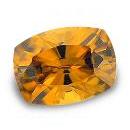|
|
|
|
Click on a letter above to view the list of gems. |
|
|
|
|
|
Zircon |
|
| Chemistry: ZrSiO4 [Zirconium Silicate] | |
| Discovered
in Prehistory;
IMA
status: Valid (pre-IMA; Grandfathered). | ||
|
| ||
|
Classification |
|
|
| |
|
Silicates | |
|
8/A.09-10 | |
|
|
9 : SILICATES (Germanates) |
|
Related to: |
Zircon Group: Zircon, Hafnon, Thorite, Coffinite, Thorogummite. Zircon - Thorogummite Series. Zircon - Hafnon Series. The Zirconium analogue of Thorite and Hafnon. The low-pressure dimorph of Reidite. |
|
|
|
|
Crystal Data |
|
|
|
|
|
Most commonly as tabular to prismatic crystals, with square cross sections, terminated by [111], to 30 cm; as irregular grains, massive. |
|
|
On [101], geniculated. |
|
|
|
|
|
Physical Properties |
|
|
|
|
|
[110] Indistinct, [111] Indistinct |
|
|
Conchoidal |
|
|
Brittle |
|
|
7.5 |
|
|
4.60 - 4.70 (g/cm3) |
|
|
Yellow in SW UV, dull red in LW UV. Thermoluminescent. Cathodoluminescent. |
|
|
Not normally radioactive but may be Mildly radioactive when it contains trace amounts of Uranium or Thorium). Metamict when radioactive. Mild; GRapi = 3,773.15 (Gamma Ray American Petroleum Institute Units) |
|
|
|
|
|
Optical Properties |
|
|
|
|
|
Reddish Brown, Yellow, Green, Blue, Gray, Colorless |
|
|
Transparent to Translucent to Opaque |
|
|
Vitreous to Adamantine; Greasy when metamict |
|
|
1.925 - 2.015 Uniaxial ( + ); Isotropic when metamict |
|
|
0.055 |
|
|
Very Strong |
|
|
Very Weak |
|
|
|
|
|
Occurances |
|
|
|
|
|
Geological Setting: |
An accessory mineral in igneous and metamorphic rocks, with crystals reaching large size in mafic pegmatites and carbonatites; in sedimentary rocks and alluvial heavy-mineral sands. |
|
Common Associations: |
Amphiboles, Feldspars, Mica, Quartz |
|
Type Locality: |
n/a (Prehistory) |
|
Year Discovered: |
Prehistory |
|
View mineral photos: | |
|
|
|
|
More Information |
|
|
|
|
|
| |
|
|
|
|
Zircon is often confused with the artificial diamond simulant Cubic Zirconia. Cubic Zirconia's formula is ZrO2 (zirconium oxide) and Zircon is ZrSiO4 (zirconium silicate). Zircon has also been used as a diamond simulant and resembles Diamond in luster and fire. Colorless Zircon may even be mistaken for a Diamond by experienced jewelers. Zircon is an attractive and affordable gemstone and is the December birthstone. U- and Th-bearing zircon is radioactive. Gemstones should be tested for radioactivity before being worn on or near the body. Zicons are commonly slightly radioactive due to trace amounts of uranium. Estimated Radioactivity from Zircon Zircon
is a very widely distributed mineral, but fine crystals
are relatively rare. |
|
|
We
have not photographed our Zircon
gems. Please
check back soon. |

 - mild
- mild